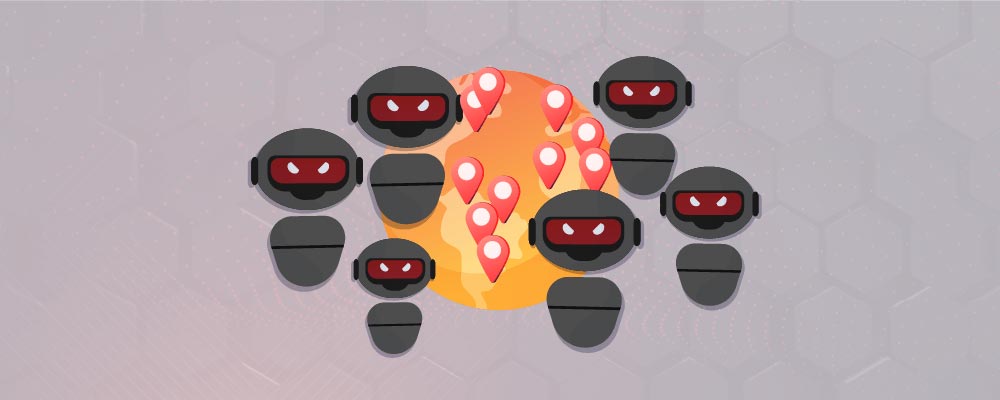A Distributed Denial-of-Service Attack (DDoS) is a type of cyber threat that targets a resource, such as a network or web server, with an overwhelming amount of requests to take it offline. Once the traffic shoots past the server’s capacity, it is unable to respond to legitimate requests from legitimate users, resulting in the “denial of service.”
DDoS attacks involve multiple machines working together in a network to flood the server with a large amount of traffic that is beyond its capacity. They are often perpetrated by malicious actors and directed at large businesses that people depend on for essential services, such as banks, news websites, and, in some cases, even power plants. The end goal could also vary from theft and extortion during the system outage and downtime to the launch of additional attacks like phishing and ransomware, reputation damage, or simply causing anarchy.
The Workings of a DDoS Attack
DDoS attacks occur when a network of compromised devices, known as a botnet, are remotely controlled by attackers to flood a target resource with malicious traffic, which could include various devices such as laptops, mobiles, servers, and IoT devices.
The botnet is created by injecting malware into the devices. Once the botnet is created, remote instructions are sent to each bot to carry out an attack. DDoS attacks are hard to detect as each bot sends traffic that looks normal and is hard to separate from legitimate traffic, which is part of the reason DDoS attack protection is so important.
Read More: How DDoS Attacks Work

How Disruptive a DDoS Attack Can Be?
One of the key reasons why DDoS attacks are dangerous is because of their simplicity. To create and launch a DDoS attack does not require any seriously sophisticated techniques. A hacker does not have to install any code on the target server. All it takes is to compromise machines and control them to send millions of pings to the targeted web server simultaneously. In fact, the Mirai botnet used in the Dyn attack of 2016 was open-source, which meant that any cybercriminal could use and adapt it to launch attacks with the same functionality in the future.
DDoS attacks are also tricky to defend against since the incoming internet traffic is distributed. The botnet’s compromised “zombie” machines have different source IP addresses. Adding filters to block requests from suspicious IP addresses is one countermeasure. Still, when there are millions of such IP addresses, it becomes an unsustainable defense strategy when such a large number of requests are being made.
To make matters worse, the potential attack vectors in DDoS attacks are increasing every day. As more devices enter the hands of everyday consumers and as the IoT market expands to cover more types of devices, defending against potential DDoS attacks from these becomes more challenging. These devices may not have advanced security software compared to a standard computer or server and, therefore stay vulnerable to being hacked and compromised to form part of the botnet.
The Different Types of DDoS Attacks
DDoS attacks come in different types, including networking layer or protocol attacks that target the network infrastructure, application layer attacks that cripple apps directly, and volume-based traffic attacks that rely on the sheer amount of traffic sent beyond the network bandwidth. These attacks can be intended for flooding or crashing a system, and can be launched through various methods, such as HTTP, DNS, or ICMP. The severity of each attack is measured differently, depending on the type and method used.
Read More: Types of DDoS Attacks

How to Identify DDoS Attacks in Order to Protect Against Them
As mentioned before, DDoS attacks can be hard to detect since they involve traffic from devices that are legitimate, even if they may be part of a remote-controlled botnet. This makes it hard to distinguish such botnet traffic from legitimate requests. However, there are a few symptoms that you can look out for in trying to identify and protect your business against DDoS attacks.
To protect against DDoS attacks, monitor sudden performance drops and look for signs of attack traffic from specific IP addresses, device types, locations, or browsers. Investigate traffic directed unusually toward a single webpage or spikes during odd hours or at regular short intervals.
In addition to monitoring performance drops, it’s important to identify unusual technical issues that may signal a DDoS attack. Slow network performance, difficulties in opening files, or accessing websites might be precursors to an attack. Scrutinizing these issues can help determine if they stem from a DDoS threat.
Read More:
DDoS Mitigation for Your Business
DDoS protection has become an essential component of cybersecurity for businesses today.
DDoS attacks involve the attacker relying on strength in numbers of bots or compromised devices to overwhelm a target network resource. Despite the simplicity of the methods used, DDoS attacks can cause major damage to businesses, including server downtime, interruption of services to customers, and as a pathway to launch other more expansive attacks. Here are some simple rules to follow:
Immediate Response and Mitigation
As soon as a DDoS attack is detected, the first step is to mitigate its effects. This can be done by deploying specific tools or services that can identify and filter out harmful traffic, allowing genuine traffic to reach its destination without any issues.
However, to effectively implement DDoS protection strategies, it is not enough to merely identify symptoms and then react to the onslaught in real-time. By the time a DDoS threat is detected, part or most of the damage might already be done and you are likely in a race against time to minimize the extent of the damage. This is why it is critical to be proactive and explore DDoS mitigation cloud services for your business.
Assessment and Analysis
Once the attack has been mitigated, it’s important to assess the damage caused thoroughly. This involves analyzing system logs and network traffic to understand the extent of the attack and identify any exploited vulnerabilities.
Tightening Security Policies
Strengthening security policies is a crucial step in recovering from a DDoS attack. This may include implementing stricter access controls, firewall rules, and intrusion detection/prevention systems to better safeguard against future attacks.
Professional services, including DNS and service providers like CDNetworks, can help you protect your network and systems with network monitoring tools and technologies, such as content delivery networks, for routing malicious attack traffic as needed.


